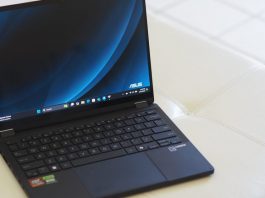AMD did exactly what I hoped it would do. Its Fluid Motion Frames feature, referred to as AFMF, originally promised a way to add frame generation to virtually any game. There was just one problem — AFMF was bad. Really bad. Now, AMD is taking another swing at driver-level frame generation with AFMF 2, which works in any game for any of AMD’s RX 6000 or RX 7000 graphics cards.
The new version takes a lot of cues from Lossless Scaling, a $7 Steam app that has catapulted in popularity over the past few months due to its ability to add frame generation to any game. AMD is now able to provide a similar level of quality, and with some clear upsides over Lossless Scaling if you own one of AMD’s best graphics cards.
What’s new here?
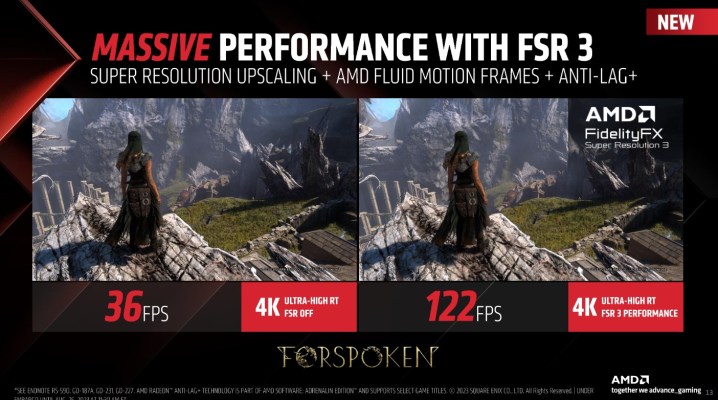
AMD calls AFMF 2 a “significant upgrade” over the original version, so it’s worth looking at what exactly that means. First and most prominently is AI, which is a tricky aspect of AFMF 2 to cover. The feature doesn’t use AI like Nvidia’s DLSS 3.5. There’s no AI inference — the task of actually running a model locally — happening when you turn AFMF 2 on. Instead, AMD used AI to develop the algorithm for AFMF 2 that’s deployed through the driver.
It’s better described as machine learning — AMD leveraged machine learning to develop an algorithm, so there’s no AI funny business happening in real time. It’s a similar approach as we’ve seen with Lossless Scaling. Instead of requiring specific hardware to run an AI model, AMD is passing along some benefits it saw from developing an algorithm with AI. Because of this approach, AFMF 2 works on just about any device that the original feature worked on.
The benefits of AI most clearly show up in the new Search Mode. The original AFMF didn’t include any settings, but AFMF 2 includes two new options, one of which is Search Mode. According to AMD, this adjusts how fallback works in AFMF 2. The feature will automatically turn itself off during fast motion, just like the original, in order to preserve image quality. Now, AMD is giving users some control over how the fallback works.
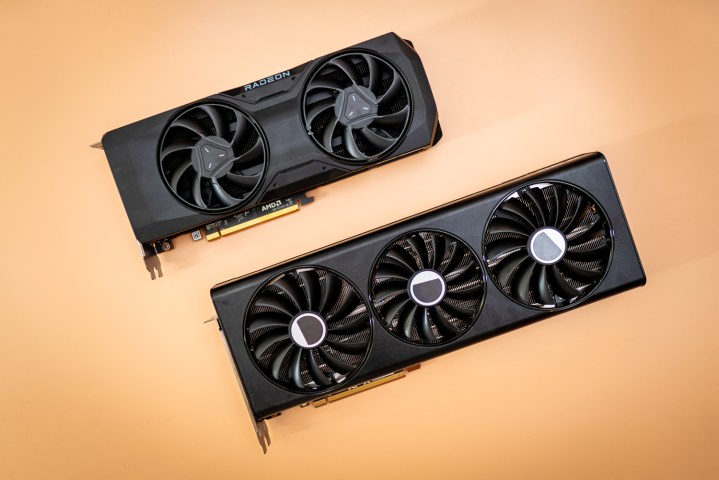
This fallback was one of the biggest issues with the original AFMF. It led to a wildly inconsistent experience, where you would oscillate between a high and low frame rate during any fast motion. Now, you can use the High Search Mode, which reduces how often the fallback triggers. AMD recommends only using this mode at a resolution of 1440p or above.
That’s the big difference, but AMD also added a Performance mode with AFMF 2. This is built specifically for integrated graphics, reducing the image quality and the overhead of running AFMF 2 on top of your game. It’s a great option to have, as we’ve seen how these display-level frame interpolation features can actually reduce performance if you have weaker integrated graphics.
AFMF 2 is much different than the original, but AMD went beyond just updating the algorithm. AFMF 2 now supports exclusive full screen and borderless full screen in games, and it works with just about any graphics API. Previously, it was restricted to DirectX 11 and DirectX 12, but AFMF 2 now supports Vulkan and OpenGL, as well.
Let’s look at the numbers
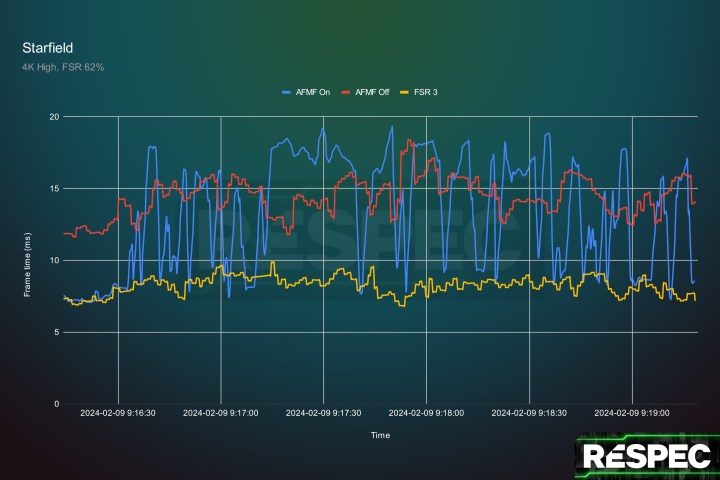
One of my biggest issues with the original AFMF was how inconsistent it was. The fallback was extremely aggressive, especially in first-person games, leading to an experience that felt less smooth than just turning the feature off. You can see that in action with the frame time chart in Starfield above. There are these wild peaks and valleys, which represent shooting from a high frame rate to a low frame rate.
If you’ve never seen one of these charts before, it’s worth explaining them before going deeper. This is frame time over time. Each line shows the amount of time between each frame over the course of a few minutes. The higher the frame time, the lower the frame rate, and vice versa. We’re less concerned with where the line ends up overall and more concerned with the consistency. A flat line means there’s consistent time between each frame, which will feel better to play than something that’s bouncing all over the place.

Now look at AFMF 2 above. What a difference! Using a native FSR 3 implementation is definitely the most consistent of the three options, but AFMF 2 is remarkably close. It’s a far cry from the wild variation in frame time I saw previously with AFMF, which made a first-person game like Starfield completely unplayable, especially during intense action scenes. Now, AFMF 2 is a real option.
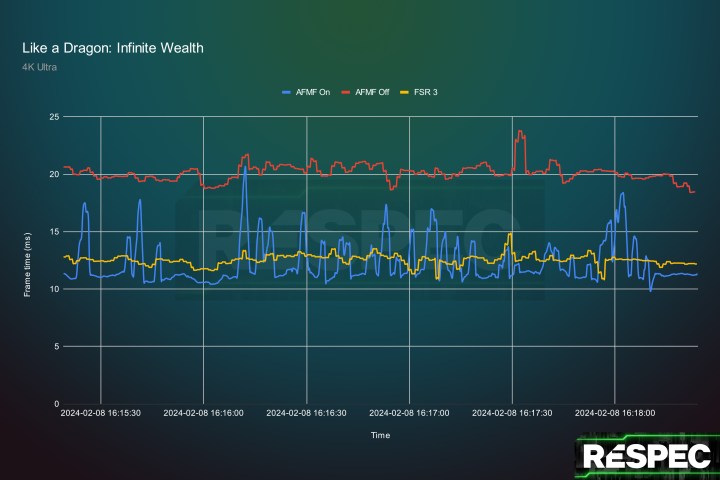
With the first version of AFMF, Starfield was, by far, the worst experience. There were still problems in other games, though, as you can see in Like a Dragon: Infinite Wealth above. This is a third-person game where all of the combat is turn-based. It’s the type of game where AFMF should shine, with relatively smooth camera movements and little in the way of fast-paced action. Even then, you can see how the original version of AFMF struggled to maintain a consistent frame time.
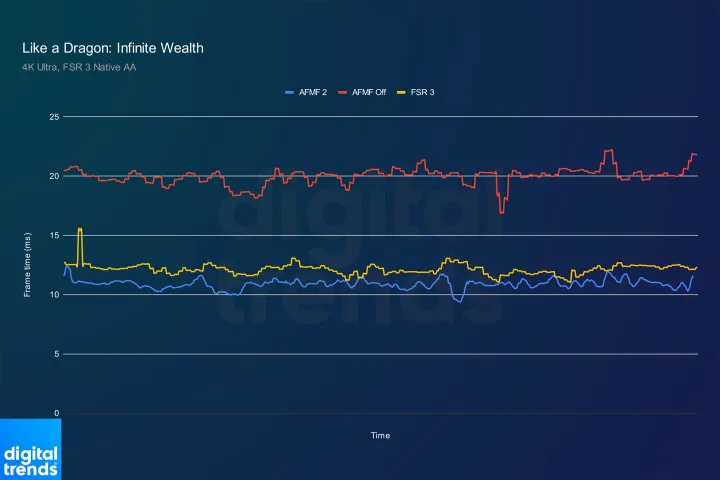
And once again, AFMF 2 is remarkably better. Not only are the peaks gone from the frame time but AFMF 2 actually provided a lower frame time than native FSR 3 (and therefore a higher frame rate). There’s a little more to the story than just the frame time here, though.
It doesn’t show up on a frame time chart like this — samples are only taken every second and averaged over that second — but AFMF 2 definitely had some micro-stuttering. It only popped up during more intense moments of gameplay, which leads me to believe AMD is opening and closing the fallback window much faster with AFMF 2. It doesn’t kill the experience, but AFMF 2 is still a clear step below a native FSR 3 implementation as expected.
Still, there are some major improvements here. The charts really tell the full story. AMD was able to bring the biggest issue with the first version of AFMF back in line, and with some clear performance improvements in tow. AFMF 2 isn’t perfect, but it’s now a feature that is a true selling point of AMD graphics cards.
Some thoughts on image quality
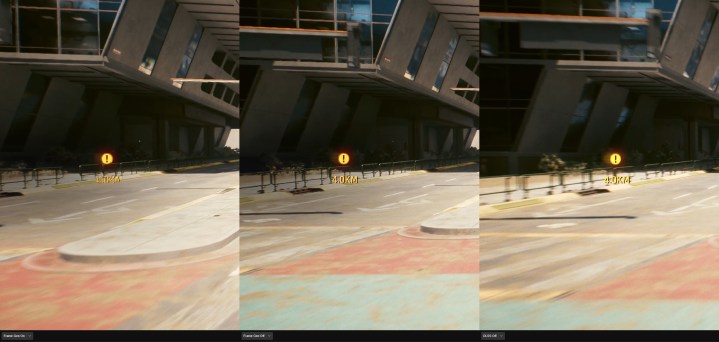
I wasn’t able to capture any video footage for AFMF 2 — due to the way it works, normal capture software doesn’t pick up on the interpolated frames, so you won’t see any of the artifacts I noticed while playing. If you’ve ever played frame interpolation through something like Lossless Scaling, you’ll know what to expect here. There’s some nasty ghosting, particularly in menus and with fine details in high contrast scenes.
If you haven’t experienced display-level frame interpolation, it’s important to keep in mind that it accounts for the entire screen. Things like a crosshair will sputter and ghost as you flick around your camera. In fairness to AFMF 2, this is an issue the original version had, too. It’s one of the main factors that distinguishes this from something like FSR 3 or DLSS 3, which can work within the game engine to remove elements like the HUD from the frame interpolation.
Another area where AFMF 2 struggles is dark patches. Particularly in a game like Elden Ring, you’ll see the tool struggle to make out the detail in dark corridors. This is an area where a tool like Lossless Scaling also struggles, however.
Although AMD clearly took notes from Lossless Scaling with AFMF 2, there are some clear upsides here. Support for both exclusive full screen and borderless full screen means you can use HDR, and you’re able to turn on the frame interpolation while a game is already launched. It worked for me every time, which is surprising. Even Lossless Scaling doesn’t always stick the first time you try to use it in a game.
AFMF 2 is a huge step forward, and it’s now a reason to truly recommend an AMD graphics card. A native FSR 3 implementation is always better, and AMD has slowly been growing the list of supported games. What I’d really like to see is support for AFMF 2 on devices like the ROG Ally X. The feature is currently in a technical preview, and it hasn’t rolled out to handhelds yet. That would be a huge boon for these portable devices.




